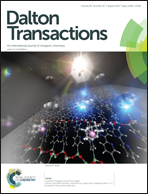An HASApf–redoxin complex causing asymmetric catalytic oxidation via the regenerative formation of a reactive oxygen species†
Abstract
A PP (pea)-HASApf–redoxin complex eluted from encapsulated PP gel with aeration displays asymmetric oxidation activity over 200 times greater than that of a similar protein expressed by E. coli cells. The intermediate spin, identified in the ESR spectrum, appears at g = 4.3 and g = 2.0, suggesting that an iron electron-transfer system for the asymmetric oxidation of secondary alcohols may be successfully created by the PP-HASApf–redoxin complex (39 kDa). FTIR experiments provided values νs(SO2) ≈ 950–1050 cm−1 and νas(SO2) ≈ 1100–1200 cm−1 for metal-bound sulfinate S–O and Fe–O vibrations. The sulfur and iron detected by physicochemical inspection (IC/ICP-AES) may facilitate the electron transport of a sulfate–iron complex (e.g., rubredoxin (6 kDa) or ferredoxin (9 kDa)) to the HASApf (21 kDa). The observations are consistently acceptable; i.e., the oxygen-driven PP–HASApf–redoxin complex functions regenerate via the successive asymmetric catalytic event – Fe(II) + O2 → Fe(III)–O–O− → Fe(IV) = O (oxidizing rac-1 or rac-2) → Fe(II) + H2O. Therefore, the use of a raw biomaterial as a PP-HASApf–redoxin complex-catalytic system for asymmetric oxidation is an important novelty, despite the apparent difficulties in working with pure dehydrogenase enzymatic/redox-cofactor systems for biotransformation.


 Please wait while we load your content...
Please wait while we load your content...